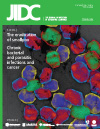Activity of solvent extracts of Prosopis spicigera, Zingiber officinale and Trachyspermum ammi against multidrug resistant bacterial and fungal strains
DOI:
https://doi.org/10.3855/jidc.621Keywords:
Multidrug resistance, ESBLs, plant extracts, bacteria, fungusAbstract
Background: The emerging trends of multidrug resistance among several groups of microorganisms against different classes of antibiotics led different researchers to develop efficient drugs from plant sources to counter multidrug resistant strains. This study investigated different solvent extracts of Prosopis spicigera (P. Spicigera), Zingiber officinale, and Trachyspermum ammi (T. ammi) to determine their efficacy against multidrug resistant microbes.
Methodology: Successive extractions of these plants were performed using a Soxhlet apparatus, using solvents with increasing polarities. Preliminary phytochemical analysis was also performed .Minimum inhibitory concentration was determined by a two-fold serial dilution method followed by determination of minimum bactericidal/fungicidal concentration. Multidrug resistant (MDR) strains of Candida albicans, Candida krusei, Candida tropicalis, Candida glabrata, Escherichia coli and reference strains of Streptococcus mutans and Streptococcus bovis were used in the study.
Results: The ethanolic fraction of P. spicigera (least minimum inhibitory concentration [MIC] - 4.88 µg/ml) demonstrated a remarkable inhibition of the microorganisms while fractions obtained from those of Zingiber officinale (least MIC-78.125 µg/ml) exhibited little activity. The petroleum ether fraction of T. ammi (least MIC- 625 µg/ml) showed best activity when compared to its other fractions. Qualitative analysis of the phytoconstituents was also performed.
Conclusions: The potency shown by these extracts recommends their use against multidrug resistant microorganisms. This study also showed that P. spicigera could be a potential source of new antimicrobial agents.
Downloads
Published
How to Cite
Issue
Section
License
Authors who publish with this journal agree to the following terms:
- Authors retain copyright and grant the journal right of first publication with the work simultaneously licensed under a Creative Commons Attribution License that allows others to share the work with an acknowledgement of the work's authorship and initial publication in this journal.
- Authors are able to enter into separate, additional contractual arrangements for the non-exclusive distribution of the journal's published version of the work (e.g., post it to an institutional repository or publish it in a book), with an acknowledgement of its initial publication in this journal.
- Authors are permitted and encouraged to post their work online (e.g., in institutional repositories or on their website) prior to and during the submission process, as it can lead to productive exchanges, as well as earlier and greater citation of published work (See The Effect of Open Access).








